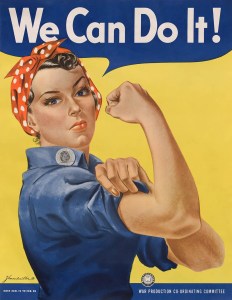This month we are going on a field trip! I visited the Rosie the Riveter/WWII Home Front National Historical Park in Richmond, California. This National Historical Park includes a small but mighty visitor’s center that has fascinating and inclusive exhibits. I encourage history buffs to check out their website.
Better yet, if you are visiting San Francisco or Oakland, take a side trip to this location. It’s set along the San Francisco Bay Trail which, to my delight, is wheelchair accessible as well as lovely.
WWII marked a time when an unprecedented number of women entered the workforce, particularly in fields that had been previously open only to men. The government used propaganda not only to encourage women to work outside the home, but also to persuade the men in their lives to allow it. One of the outcomes of this public relations effort was the creation of “Rosie the Riveter.”
Here’s how it happened: In 1942, Redd Evans and John Jacob Loeb wrote a song called “Rosie the Riveter.” It was recorded in 1943. Here’s a recording which also features photos from the Library of Congress:
Also in 1942, artist J. Howard Miller created the “We Can Do It!” poster for Westinghouse. This poster was only in use for a couple of weeks, but gained new life as a feminist poster in the 1980s. Meanwhile, Norman Rockwell painted “Rosie the Riveter” for the cover of the Saturday Evening Post. While Miller’s poster didn’t take off until decades later, Rockwell’s painting was a hit immediately. This painting, combined with the song, created a character of ‘Rosie the Riveter” that continues to shape the way we think about the capabilities and roles of women.


One thing that the Visitor’s Center makes clear is that many women of color felt that the Rosie story is a story exclusively about middle and upper class White women. After all, many women of color were already working outside the home not because of patriotic fervor but because of financial necessity. Women of color usually were hired only after White women, were given less prestigious and more dangerous work, were paid less, and were the first to be fired.
The Visitor’s Center has displays about the vital work that was done by people of color, as well as disabled people and LGBTQIA+ people. It also talks about the shameful incarceration of Japanese American citizens that the government carried out in California during the war.
Above all, the museum displays the tremendous social impact that WWII had on working communities as they travelled to shipyards such as the one in Richmond, and to other industrialized centers. People scrambled for housing. They petitioned for on-site daycare, workplace safety, and healthcare. The efforts of women of all backgrounds proved vitally influential for later civil rights, labor, and women’s rights movements.

I highly recommend a visit to the memorial if you get a chance. If you go on Friday, you can meet a real-life Rosie the Riveter who will answer questions about their experiences! You can also buy Sign My Name to Freedom, an autobiography written by Betty Reid Soskin, an African American woman who helped develop the center and who, as of 2013, was America’s oldest National Park Service Ranger (she has since retired).
If you can’t visit in person, do check out the website which tells the stories of many Kickass Women. If you have a favorite museum, visitor’s center, or other location that highlights Kickass Women, tell us in the comments!
Someone you know wants to read this, right?
